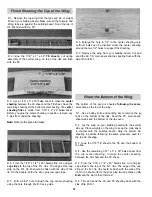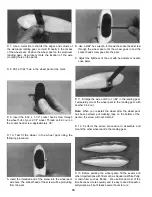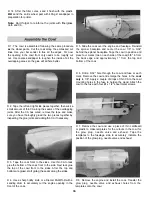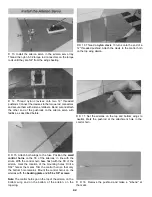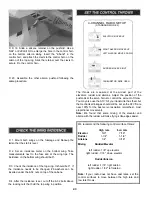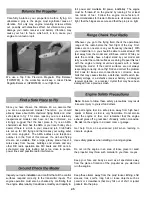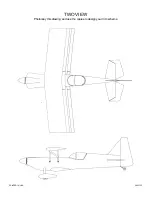
Carefully balance your propellers before flying An
unbalanced prop is the single most significant cause of
vibration Not only may engine mounting screws vibrate
out, possibly with disastrous effect, but vibration may also
damage your radio receiver and battery Vibration may
cause your fuel to foam, which will, in turn, cause your
engine to run lean or quit.
full power and maintains full power, indefinitely The engine
must be "broken-in" on the ground by running it for at least
two tanks of fuel Follow the engine manufacturer's
recommendations for break-in Make sure all screws remain
tight, that the hinges are secure and that the prop is on tight
We use a Top Flite Precision Magnetic Prop Balancer
(TOPQ5700) in the workshop and keep a Great Planes
Fingertip Balancer (GPMQ5000) in our flight box.
Whenever you go to the flying field, check the operational
range of the radio before the first flight of the day First,
make sure no one else is on your frequency (channel) With
your transmitter on, you should be able to walk at least 100
feet away from the model and still have control While you
work the controls, have a helper stand by your model and
tell you what the control surfaces are doing Repeat this test
with the engine running at various speeds with a helper
holding the model If the control surfaces are not always
responding correctly, do not fly! Find and correct the problem
first Look for loose servo connections or corrosion, loose
bolts that may cause vibration, a defective on/off switch, low
battery voltage or a defective receiver battery, a damaged
receiver antenna, or a receiver crystal that may have been
damaged from a previous crash.
Since you have chosen the Ultimate 40, we assume that
you are an experienced modeler Therefore, you should
already know about AMA chartered flying fields and other
safe places to fly If for some reason you are a relatively
inexperienced modeler and have not been informed, we
strongly suggest that the best place to fly is an AMA
chartered club field Ask the AMA or your local hobby shop
dealer if there is a club in your area and join Club fields
are set up for R/C flying and that makes your outing safer
and more enjoyable The AMA address and telephone
number is in the front of this manual If a club and flying
site are not available, find a large, grassy area at least 6
miles away from houses, buildings and streets and any
other R/C radio operation like R/C boats and R/C cars. A
schoolyard may look inviting but is too close to people,
power lines and possible radio interference.
Note: Failure to follow these safety precautions may result
in severe injury to yourself and others.
Keep all engine fuel in a safe place, away from high heat,
sparks or flames, as fuel is very flammable Do not smoke
near the engine or fuel, and remember that the engine
exhaust gives off a great deal of deadly carbon monoxide.
Do not run the engine in a closed room or garage.
Get help from an experienced pilot when learning to
operate engines.
Use safety glasses when starting or running engines.
Do not run the engine in an area of loose gravel or sand;
the propeller may throw such material in your face or eyes
Keep your face and body as well as all spectators away
from the plane of rotation of the propeller as you start and
run the engine.
Inspect your radio installation and confirm that all the control
surfaces respond correctly to the transmitter inputs The
engine operation must also be checked by confirming that
the engine idles reliably, transitions smoothly and rapidly to
Keep these items away from the prop' loose clothing, shirt
sleeves, ties, scarfs, long hair or loose objects such as
pencils or screwdrivers that may fall out of shirt or jacket
pockets into the prop.
45

